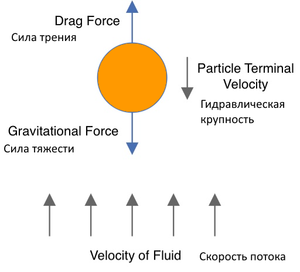Fall velocity: различия между версиями
Перейти к навигации
Перейти к поиску
Esmoreido (обсуждение | вклад) |
Avdeevdm (обсуждение | вклад) |
||
| Строка 5: | Строка 5: | ||
==Определение на английском== | ==Определение на английском== | ||
| − | The particular falling speed, for any given object moving through a fluid medium of specified physical properties, at which the drag forces and buoyant forces exerted by the fluid on the object just equal the gravitational force acting on the object <ref> | + | The particular falling speed, for any given object moving through a fluid medium of specified physical properties, at which the drag forces and buoyant forces exerted by the fluid on the object just equal the gravitational force acting on the object. <ref>Ralph E.H. Glossary of meteorology. – Boston: American Meteorological Society, 1959. – 638 p.</ref> |
==Пример использования термина на английском языке== | ==Пример использования термина на английском языке== | ||
| − | Fall velocities are estimated analytically from a balance of settling and diffusive flux gradients using two methods, one employing Reynolds concentration flux, and the other estimating eddy diffusivity using the von-Karman Prandtl equation. <ref>Fugate D | + | |
| + | # Fall velocities are estimated analytically from a balance of settling and diffusive flux gradients using two methods, one employing Reynolds concentration flux, and the other estimating eddy diffusivity using the von-Karman Prandtl equation. <ref name=":0">Fugate D.C., Friedrichs C.T. Determining concentration and fall velocity of estuarine particle populations using adv, obs and lisst // Continental Shelf Research. – 2002. – Vol. 22. – № 11-13. – P. 1867-1886. <nowiki>https://doi.org/10.1016/S0278-4343(02)00043-2</nowiki>.</ref> | ||
| + | # Fall velocity (FV) is such a fundamental parameter for sediment researchers that its accurate determination has been regarded as a top priority in improving numerical modelling and conceptual understanding of fine sediment dynamics.<ref name=":1">Wan Y., Wu H., Roelvink D., Gu F. Experimental study on fall velocity of fine sediment in the Yangtze Estuary, China // Ocean Engineering. – 2015. – Vol. 103. – P. 180-187. <nowiki>https://doi.org/10.1016/j.oceaneng.2015.04.076</nowiki>.</ref> | ||
| + | # Along the water depth, the fall velocity increased monotonically with a gradually decreasing gradient. <ref name=":2">Yang J., Tang L., She Y., Sun J. Laboratory measurements of the fall velocity of fine sediment in an estuarine environment // International Journal of Sediment Research. – 2020. – Vol. 35. – № 2. – P. 217-226. <nowiki>https://doi.org/10.1016/j.ijsrc.2019.08.003</nowiki>.</ref> | ||
==Перевод использования на русском языке== | ==Перевод использования на русском языке== | ||
| − | Гидравлическая крупность оценивалась аналитически на основе баланса градиентов | + | |
| + | # Гидравлическая крупность оценивалась аналитически на основе баланса градиентов осаждения и диффузионного потоков, при помощи использования двух методов, один из которых использует концентрационный поток Рейнольдса, а другой оценивает вихревую диффузию с помощью уравнения Кармана-Прандтля.<ref name=":0" /> | ||
| + | # Гидравлическая крупность является фундаментальным параметром для русловедов, поэтому его точное определение рассматривается как первоочередная задача для улучшения численного моделирования и концептуального понимания динамики наносов.<ref name=":1" /> | ||
| + | # Гидравлическая крупность монотонно возрастала с постепенно уменьшающимся градиентом.<ref name=":2" /> | ||
==Список литературы== | ==Список литературы== | ||
Версия 00:11, 26 апреля 2024
Гидравлическая крупность
Cкорость равномерного падения твердых частиц, например. наносов в неподвижной воде. Частицы, обладающие удельным весом меньше единицы (кристаллы (льда), имеют отрицательную гидравлическую крупность: эти частицы в неподвижной воде поднимаются.[1]
Определение на английском
The particular falling speed, for any given object moving through a fluid medium of specified physical properties, at which the drag forces and buoyant forces exerted by the fluid on the object just equal the gravitational force acting on the object. [2]
Пример использования термина на английском языке
- Fall velocities are estimated analytically from a balance of settling and diffusive flux gradients using two methods, one employing Reynolds concentration flux, and the other estimating eddy diffusivity using the von-Karman Prandtl equation. [3]
- Fall velocity (FV) is such a fundamental parameter for sediment researchers that its accurate determination has been regarded as a top priority in improving numerical modelling and conceptual understanding of fine sediment dynamics.[4]
- Along the water depth, the fall velocity increased monotonically with a gradually decreasing gradient. [5]
Перевод использования на русском языке
- Гидравлическая крупность оценивалась аналитически на основе баланса градиентов осаждения и диффузионного потоков, при помощи использования двух методов, один из которых использует концентрационный поток Рейнольдса, а другой оценивает вихревую диффузию с помощью уравнения Кармана-Прандтля.[3]
- Гидравлическая крупность является фундаментальным параметром для русловедов, поэтому его точное определение рассматривается как первоочередная задача для улучшения численного моделирования и концептуального понимания динамики наносов.[4]
- Гидравлическая крупность монотонно возрастала с постепенно уменьшающимся градиентом.[5]
Список литературы
- ↑ Чеботарев А.И. Гидрологический словарь.-3-е изд., перераб. и доп. - Л : Гидрометеоиздат, 1978, 308 с.
- ↑ Ralph E.H. Glossary of meteorology. – Boston: American Meteorological Society, 1959. – 638 p.
- ↑ Перейти обратно: 3,0 3,1 Fugate D.C., Friedrichs C.T. Determining concentration and fall velocity of estuarine particle populations using adv, obs and lisst // Continental Shelf Research. – 2002. – Vol. 22. – № 11-13. – P. 1867-1886. https://doi.org/10.1016/S0278-4343(02)00043-2.
- ↑ Перейти обратно: 4,0 4,1 Wan Y., Wu H., Roelvink D., Gu F. Experimental study on fall velocity of fine sediment in the Yangtze Estuary, China // Ocean Engineering. – 2015. – Vol. 103. – P. 180-187. https://doi.org/10.1016/j.oceaneng.2015.04.076.
- ↑ Перейти обратно: 5,0 5,1 Yang J., Tang L., She Y., Sun J. Laboratory measurements of the fall velocity of fine sediment in an estuarine environment // International Journal of Sediment Research. – 2020. – Vol. 35. – № 2. – P. 217-226. https://doi.org/10.1016/j.ijsrc.2019.08.003.
